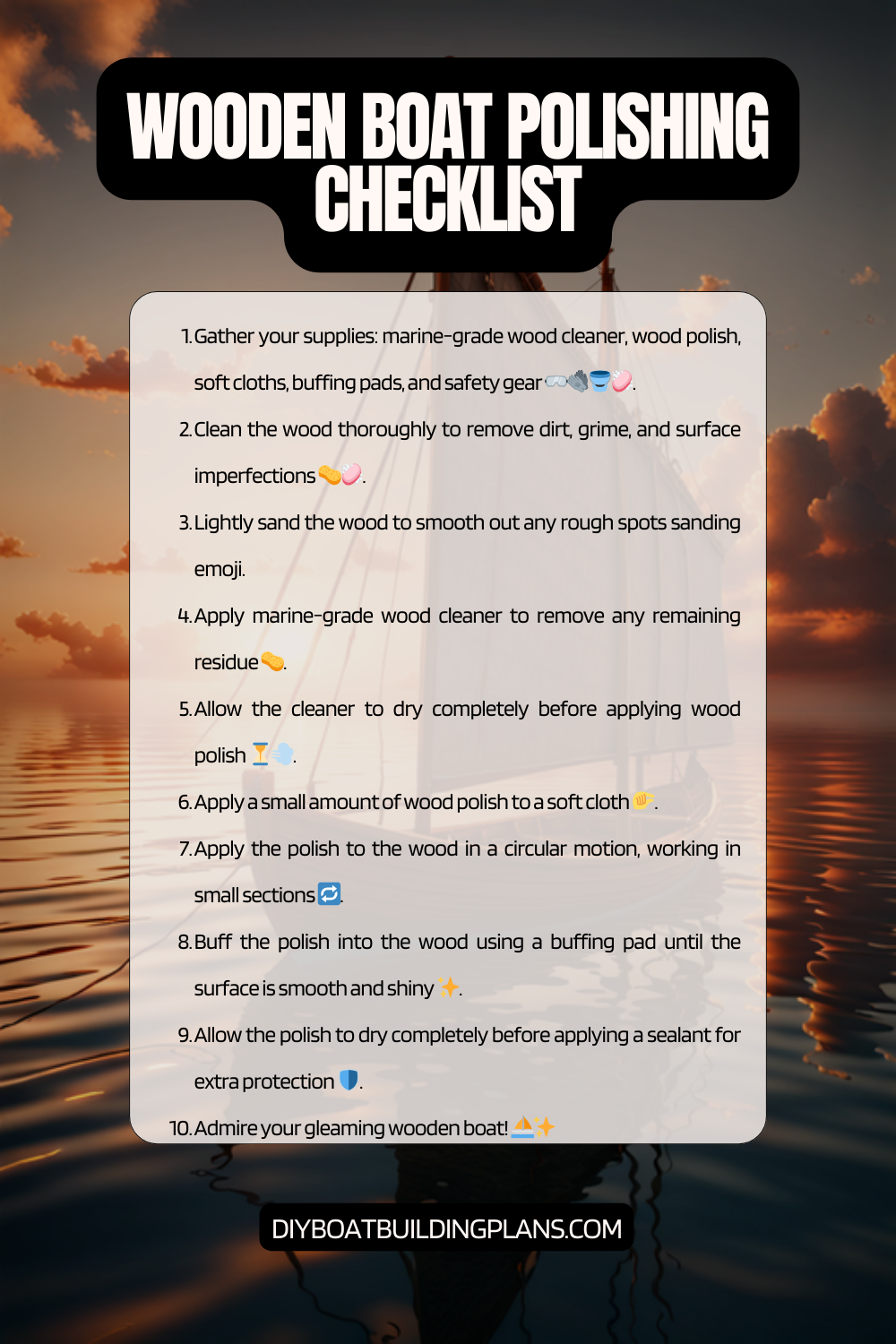Overview of Wooden Boat Polishing Tips
Wooden boat polishing is the process of restoring and maintaining the shine and beauty of a wooden boat’s exterior. It involves using specialized products and techniques to remove dirt, grime, and oxidation from the wood, and then applying a protective polish to enhance its appearance and protect it from the elements. Polishing a wooden boat is not only about aesthetics; it is also crucial for the longevity and performance of the vessel.
Maintaining a polished wooden boat is essential for several reasons. Firstly, it provides protection against harmful UV rays from the sun. Over time, prolonged exposure to sunlight can cause the wood to fade, crack, and deteriorate. By regularly polishing the boat, you create a barrier that shields the wood from these damaging rays, preserving its natural color and preventing sun damage.
Secondly, polishing enhances the appearance of the boat. A well-polished wooden boat exudes elegance and charm, attracting attention wherever it goes. The glossy finish brings out the natural beauty of the wood grain, making it a sight to behold. Whether you’re cruising on calm waters or participating in a boat show, a polished wooden boat will undoubtedly turn heads and make a lasting impression.
Lastly, polishing increases the lifespan of the boat. Wooden boats are susceptible to water damage, including rotting and warping. By regularly polishing your boat, you create a protective layer that repels water and prevents it from seeping into the wood. This helps to maintain the structural integrity of the boat, ensuring that it remains seaworthy for years to come.
Key Takeaways
- Polishing wooden boats is important to maintain their appearance and protect them from the elements.
- Different types of wooden boats require different polishing products and techniques.
- Proper preparation, application, and finishing are key to achieving a polished look.
- Regular maintenance is necessary to keep the wooden boat looking its best.
- Common mistakes to avoid include using the wrong products and not following proper techniques.

Why Polishing Wooden Boats is Important
1. Protection against UV rays and water damage: As mentioned earlier, polishing provides a protective barrier against harmful UV rays and water damage. UV rays can cause the wood to deteriorate over time, while water can lead to rotting and warping. By regularly polishing your wooden boat, you can prevent these issues and extend its lifespan.
2. Enhances the appearance of the boat: A polished wooden boat is a thing of beauty. The glossy finish brings out the natural colors and patterns of the wood, making it visually appealing. Whether you’re a proud boat owner or a professional sailor, having a well-polished boat adds a touch of elegance and sophistication to your vessel.
3. Increases the lifespan of the boat: Wooden boats require regular maintenance to ensure their longevity. Polishing not only protects against UV rays and water damage but also helps to maintain the structural integrity of the boat. By creating a barrier that repels water and prevents rotting, polishing can significantly extend the lifespan of your wooden boat.
Types of Wooden Boats that Require Polishing
1. Classic wooden boats: Classic wooden boats, such as vintage sailboats or motor yachts, are often made from high-quality wood that requires regular polishing to maintain its beauty and integrity. These boats are often cherished for their timeless design and craftsmanship, and polishing them is an essential part of preserving their historical value.
2. Antique wooden boats: Antique wooden boats hold significant historical and sentimental value. They require meticulous care and attention to detail, including regular polishing, to ensure their preservation. Polishing an antique wooden boat not only enhances its appearance but also helps to protect it from further deterioration.
3. Modern wooden boats: While modern wooden boats may be constructed using more advanced techniques and materials, they still require regular polishing to maintain their appearance and protect them from the elements. Polishing a modern wooden boat helps to keep it looking new and ensures that it remains in top condition for years to come.
Choosing the Right Polishing Products for Wooden Boats
| Product Name | Material Type | Application Method | Price | Effectiveness |
| Teak Oil | Teak Wood | Brush or Cloth | 15 | Good |
| Marine Varnish | Various Woods | Brush or Spray | 25 | Excellent |
| Boiled Linseed Oil | Various Woods | Brush or Cloth | 10 | Fair |
| Wood Wax | Various Woods | Brush or Cloth | 20 | Good |
When it comes to choosing the right polishing products for your wooden boat, there are several factors to consider. Firstly, you need to determine the type of polish that is suitable for your boat’s specific needs. There are various types of polishes available, including paste wax, liquid polish, and oil-based products. Each type has its own advantages and disadvantages, so it’s important to choose one that is compatible with your boat’s wood type and finish.
Another factor to consider is the level of protection you require. Some polishes offer a higher level of UV protection, while others focus more on enhancing the boat’s appearance. Additionally, you should consider the ease of application and the durability of the polish. Some products require multiple coats for optimal results, while others provide long-lasting protection with just one application.
When it comes to recommended products for wooden boats, there are several trusted brands in the market. Some popular choices include marine-grade polishes from companies like 3M, Star brite, and Meguiar’s. These brands offer a range of polishes specifically formulated for wooden boats, ensuring that you get the best results without causing any damage to the wood.
Step-by-Step Guide to Polishing Wooden Boats
A. Preparing the Wooden Boat for Polishing
Before you begin polishing your wooden boat, it’s essential to prepare the surface properly. This involves cleaning the boat, sanding any rough areas, and taping off areas that should not be polished.
To clean the boat, start by removing any loose dirt or debris using a soft brush or cloth. Then, wash the boat with a mild detergent and water solution, using a sponge or soft brush to gently scrub away any stubborn stains or grime. Rinse thoroughly with clean water and allow the boat to dry completely before proceeding.
Next, inspect the boat for any rough areas or imperfections in the wood. Use sandpaper or a sanding block to smooth out these areas, working in the direction of the wood grain. Be careful not to sand too aggressively, as this can damage the wood.
Finally, tape off any areas that should not be polished, such as metal fittings or windows. This will help to protect these areas from accidental contact with the polish.
B. Applying the Polish to the Wooden Boat
Once the boat is properly prepared, it’s time to apply the polish. There are two main methods for applying polish to a wooden boat: using a cloth or using a buffer.
If you choose to use a cloth, apply a small amount of polish directly onto the cloth and rub it onto the wood in circular motions. Work in small sections, applying even pressure and ensuring that the polish is evenly distributed. Continue this process until the entire boat is polished.
If you prefer to use a buffer, attach a polishing pad to the buffer and apply a small amount of polish directly onto the pad. Turn on the buffer and move it slowly across the wood, working in small sections. The buffer will help to distribute the polish evenly and create a smooth, glossy finish.
For optimal results, it may be necessary to apply multiple coats of polish. Allow each coat to dry completely before applying the next one, following the manufacturer’s instructions for drying times.
C. Buffing and Finishing the Wooden Boat
After applying the polish, it’s important to buff the boat to remove any excess product and create a smooth finish. Use a clean, soft cloth or a buffing pad attached to a buffer for this step. Buff the boat in circular motions, applying light pressure and working in small sections until all excess polish is removed.
Once you have buffed the boat, it’s time to finish it with a protective coating. There are various options available for this step, including clear varnish or marine-grade sealants. Apply the protective coating according to the manufacturer’s instructions, ensuring that you cover all exposed wood surfaces.
Allow the protective coating to dry completely before using or exposing your boat to water. This will ensure that it has sufficient time to cure and provide optimal protection for the wood.
Maintaining the Polished Wooden Boat
To keep your polished wooden boat looking its best, regular cleaning and maintenance are essential. This includes washing the boat with a mild detergent and water solution to remove dirt and grime, as well as inspecting the wood for any signs of damage or wear.
If you notice any areas that need touch-ups, such as scratches or faded spots, you can use a fine-grit sandpaper to gently sand the affected area. Then, apply a small amount of polish to a cloth and rub it onto the sanded area in circular motions. This will help to blend the touch-up with the rest of the boat’s surface.
Additionally, it’s important to reapply polish as needed to maintain the boat’s protective barrier. The frequency of reapplication will depend on various factors, including the type of polish used, the level of exposure to sunlight and water, and the overall condition of the boat. Regularly inspect your boat for signs of wear or fading, and reapply polish as necessary to keep it looking its best.
Common Mistakes to Avoid When Polishing Wooden Boats
While polishing a wooden boat is a relatively straightforward process, there are some common mistakes that should be avoided to ensure optimal results.
One common mistake is using the wrong type of polish for your boat’s specific needs. It’s important to choose a polish that is compatible with your boat’s wood type and finish. Using an incompatible polish can lead to discoloration, damage, or an uneven finish.
Another mistake is applying too much polish. While it may be tempting to apply a thick layer of polish for better protection, this can actually have the opposite effect. Excess polish can create a sticky residue that attracts dirt and grime, making it more difficult to clean and maintain your boat in the long run.
Lastly, not properly preparing the boat before polishing is a common mistake. Skipping the cleaning and sanding steps can result in poor adhesion of the polish and an uneven finish. Taking the time to properly prepare the boat will ensure that the polish adheres well and provides optimal protection and appearance.
Download over 500 Boat Plans. Click on the link below.
-->Click Here<--
Wooden Boat Polishing Checklist

Conclusion – Wooden Boat Polishing Tips
In conclusion, wooden boat polishing is a crucial part of maintaining the beauty and longevity of your vessel. By regularly polishing your wooden boat, you can protect it from UV rays and water damage, enhance its appearance, and increase its lifespan.
When choosing polishing products for your wooden boat, consider factors such as the type of polish, level of protection, ease of application, and durability. Trusted brands like 3M, Star brite, and Meguiar’s offer a range of marine-grade polishes specifically formulated for wooden boats.
Follow a step-by-step guide to properly polish your wooden boat, including preparing the surface, applying the polish, and buffing and finishing the boat. Regularly maintain your polished wooden boat by cleaning it, touching up areas that need it, and reapplying polish as necessary.
Avoid common mistakes such as using the wrong type of polish, applying too much polish, and not properly preparing the boat before polishing.
By taking care of your wooden boat through regular polishing and maintenance, you can enjoy its beauty and performance for years to come. So go ahead, invest some time and effort into polishing your wooden boat, and let it shine on the water!
FAQs – Wooden Boat Polishing Tips
What is wooden boat polishing?
Wooden boat polishing is the process of cleaning and shining the surface of a wooden boat to restore its natural beauty and protect it from damage caused by exposure to the elements.
Why is wooden boat polishing important?
Wooden boat polishing is important because it helps to protect the wood from damage caused by exposure to the sun, saltwater, and other environmental factors. It also helps to maintain the appearance of the boat and keep it looking its best.
What are some tips for polishing a wooden boat?
Some tips for polishing a wooden boat include using a high-quality marine wax, applying the wax in a circular motion with a soft cloth, and buffing the wax with a clean, dry cloth. It is also important to clean the boat thoroughly before polishing and to avoid using abrasive cleaners or tools that could damage the wood.
How often should a wooden boat be polished?
The frequency with which a wooden boat should be polished depends on a variety of factors, including the type of wood, the climate, and how often the boat is used. In general, it is recommended to polish a wooden boat at least once a year, but it may need to be done more frequently if the boat is exposed to harsh conditions.
What are some common mistakes to avoid when polishing a wooden boat?
Some common mistakes to avoid when polishing a wooden boat include using abrasive cleaners or tools, applying too much pressure when polishing, and using a wax that is not specifically designed for use on boats. It is also important to avoid polishing in direct sunlight or when the wood is hot, as this can cause the wax to dry too quickly and leave streaks or spots.



